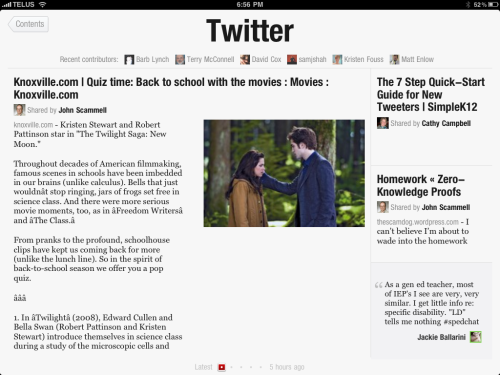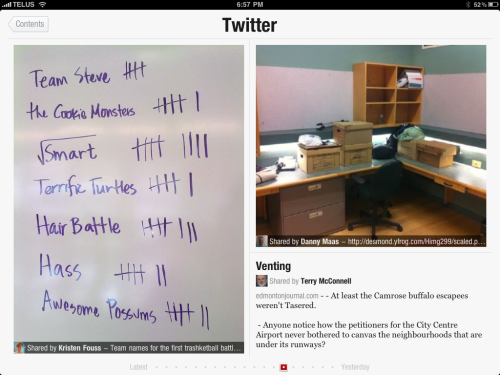A colleague recently tweeted her love for Dropbox. I made fun of her, and replied that if she was going to write an ode to Dropbox, she should at least include a referral link for extra space for herself. I have since Googled “ode” and discovered that it is another one of those things that English teachers make you write that has a lot of rules. I must state, therefore, that I know this isn’t an ode. The truth is, though, Dropbox has changed the way I work. In this post, I’m going to describe the basics of Dropbox for those of you who haven’t heard of it, and then I will explore some great uses for teachers.
Basic Explanation
Dropbox is a service that stores your files in the cloud, and syncs them automatically to any computer you set up, regardless of platform. I sync my work computer, my home computer, my iPhone, and my iPad. When I work on a file at work and save it in my Dropbox folder on my laptop, that file is automatically updated at home on my desktop. In the past, I would have emailed files back and forth to myself, or carried them on a memory stick, and constantly worried that I was overwriting a file I needed with an older version of itself. Dropbox is much more convenient. It also allows me access to those files from any computer with an internet connection through the Dropbox website, in the event that I need something and don’t have my own laptop there.
Dropbox gives users 2 GB of storage at no cost. The free storage available can be increased by referring others. For every referral, you get an extra 250 MB of storage, up to what they say is a maximum of 8 GB. Through referrals, however, I have worked my way up to 8.25 GB of free storage. It’s not listed on their site, but I think I read at one point that the free maximum was being increased to 10 GB, which might explain how I got to 8.25.
People who use Dropbox regularly and need more space can purchase that space. $9.99 per month gets you 50 GB of storage, and $19.99 per month will get you 100 GB of storage. I have a neighbor who runs a small business. He uses Dropbox as his company server because it is cheaper than installing all the hardware needed to set up his own.
Dropbox also allows you to share selected files and folders with people. I share a photos folder with my mother, so she can access full resolution pictures of her grand-daughter. I share a presentations folder with a colleague so we can share our work presentations with each other. Dan has shared a folder with me into which he is placing his programs as he hammers through Project Euler. These are just a few of my shared folders.
Uses for Educators
As an educator, I have found many practical uses for Dropbox. When I visit a school and do a presentation about our new math curriculum, my presentation is often a large file with embedded video and pictures. Participants invariably want a digital copy of the presentation, but it is too large to e-mail. In the past, that meant asking participants to bring memory sticks, and copying the presentation to their sticks one at a time. With Dropbox, I just put the large file in a public folder, and share the link to the file with the participants. Problem solved.
Another benefit of Dropbox for educators is the ability to collaborate easily on files. It’s not Google Docs, where multiple people can edit simultaneously, but it allows multiple people to access and revise the same file, always maintaining the most recent version. Way back in August, I worked with a group of teachers on some planning. They wanted to share their work, and asked me if they could email me documents, which I would then forward out to the rest of the group. After explaining that I wasn’t their secretary, I showed them Dropbox, set up a shared folder and gave the entire group access, and let them post their stuff to that folder. Four months later, members of that group are still contributing items to that shared folder, thereby reducing the planning workload for everyone.
A colleague, Russell Lyons, recently showed me how he is using Dropbox in his classroom, and it is brilliant. The iPhone Dropbox app allows you to take a photo right from within the app. That photo is instantly synced to your account, making it available to any computer you have set up. So if you don’t have a document camera, but would like to model good student work, you just snap a photo with Dropbox, and project it within seconds from your classroom computer. The quality is surprisingly good. This picture below is one I took at one of my sessions. Within seconds, I was able to discuss this group’s work with the whole class by projecting it on the SMART Board. It should be noted that they were working on this problem, from Andrew Shores’ blog.

Another place I use Dropbox is on this blog. I can’t upload videos on this blog through WordPress, without upgrading my account and paying for the privilege. Since I have a free Dropbox account, when I want to post a video on this blog, I put it in a public Dropbox folder, and then paste the link on this site. It’s not quite as nice as posting the video directly here, but it is free.
If you are not a Dropbox user, I suggest checking it out. Their introductory video explains pretty clearly what they are all about.
Read Full Post »



















